Our recommendations are made independently through Research & Testing. We may receive commissions from purchases made via our links.
Things to Keep in Mind When Buying an Electric Skillet
Fancy an electric skillet? We show you exactly why you need one. Plus, 8 things to know when looking for the best electric skillet.

A typical electric skillet only has three main parts. However, these handy appliances tend to differ in terms of heating times, evenness of heat distribution, user-friendliness, and the space they take up. Our checklist of 8 key points will take you through everything you need to know about the cooking pan, the glass lid, and the thermostat control.
1. Choose the Right Size
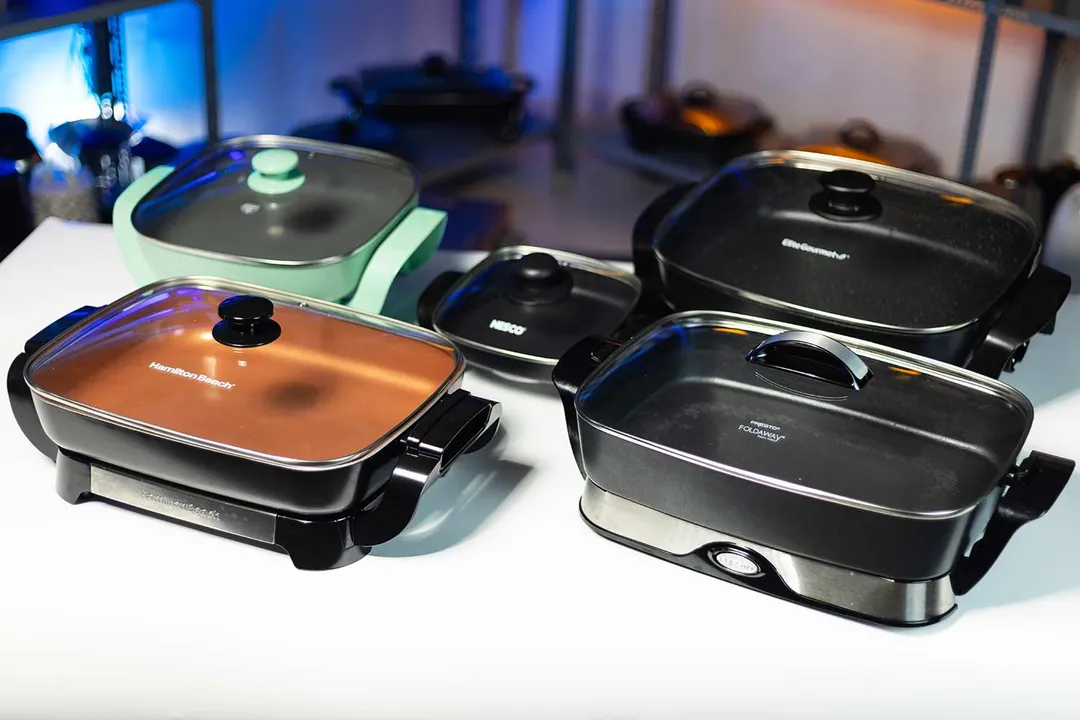
Electric skillet sizes aren’t really set in stone but you can still categorize them based on the surface cooking area:
- Small electric skillets are usually between 6 and 10 inches wide and less than 2 inches deep. This cooks enough for 1-2 people or a couple of chicken breasts.
- Medium-sized electric skillets are over 10 to 14 inches wide and 2 inches deep. You can sear 4-6 chicken breasts, whip up a 4-person stir-fry, or simmer 1 lb spaghetti.
- Large electric skillets are often over 14 inches to over 16 inches wide and around 3 inches deep. These are best for a buffet server or a family of 6 to 8.
2. Look for a High-Quality Pan
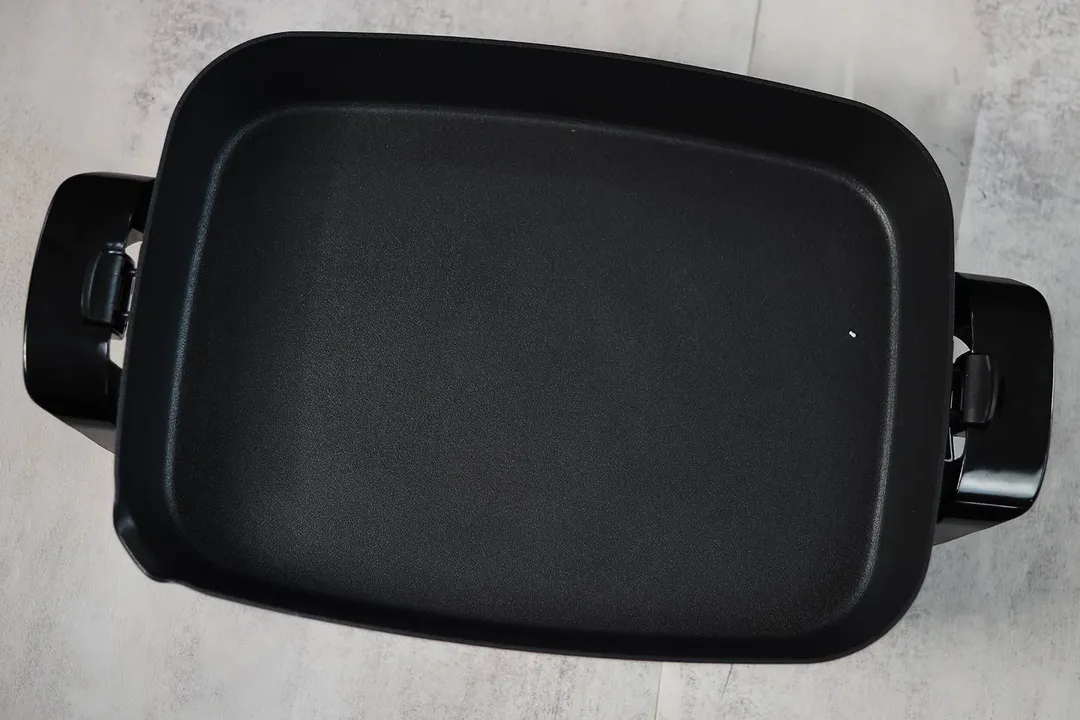
Electric skillets usually have a circular or rectangular pan. The majority have a coated cast aluminum base, but you can get ones in stainless steel.
Stainless steel pans are the safest option and are exceptionally durable. However, if you don’t heat up the pan enough, food will stick easily or you may require more greasing.
A cast aluminum skillet with a non-stick coating is easier. However, a damaged coating can leak metal into your food which is a health concern. Although non-stick is often the preferred choice, you should avoid using metal utensils or abrasive scrubbers.
From our experience, a pan thicker than 2 mm produces a more steady and even heat. Since the pans get pretty hot, a high smoke point oil or butter is better than cooking spray.
Ideally, the pan should reach 350°F, but without an infrared thermometer, there’s no real way of knowing? You can check by pouring one spoonful of water on to the pan. If the water forms droplets and you can swirl them around, then the pan is hot enough—this is called the Leidenfrost effect.
3. Non-Stick Means Less Grease and Easier Cleaning
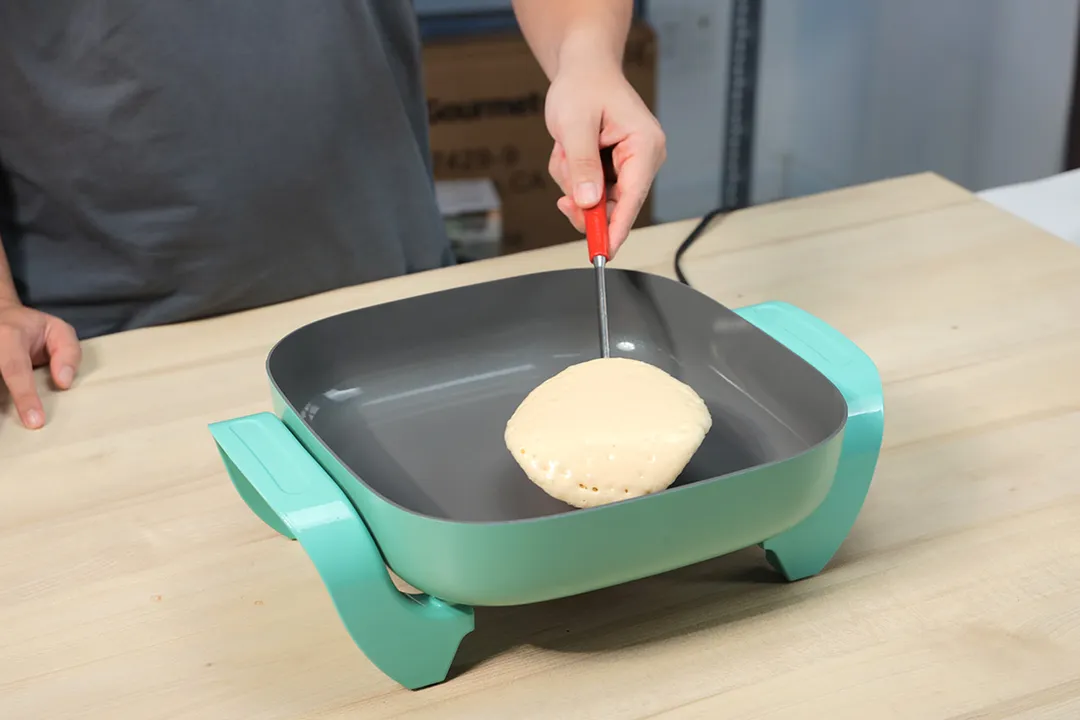
Non-stick surfaces are easy to clean. At the same time, they can offer oil-free healthier cooking, but a little greasing can extend the longevity of the coating. Also, there are different types of non-stick coatings to choose from.
A ceramic-coated pan is generally considered the safer option. Unlike Teflon (PTFE), ceramic coating is made from multiple layers of silica (silicium-dioxide) using spin coating technology.
If you see the label saying PTFE and PFOA-free, then the skillet should have ceramic coating.
A recent alternative on the rise is marble coating or ‘granite’ cookware. However, cheaper versions incorporate Teflon into the usual mixture of resins and minerals, so you have to be careful.
Most coated pans are dishwasher-safe, but we still recommend hand-washing to avoid accidental machine damage to the coating. For the same reason, don’t submerge the skillet in water for longer than two hours.
For stubborn stains from burnt food, refrain from scrubbing, especially with a metal scrubber. Just sprinkle on some baking soda, add some water to get a paste-like consistency, leave for a few minutes, then wipe with a damp soft cloth.
Lastly, let your pan cool down before you wash it. Thermal shocks lead to rapid expansion and shrinking of the metal base, which can damage the coating.
Teflon poses health concerns because PTFE degrades at high temperatures (> 250 °C) and releases toxic fumes. In addition, before 2013, PFOA was used for the chemical reaction necessary to make PTFE stickable to the surface. Nowadays, teflon-coated skillets are still the majority due to the low cost but they no longer use PFOA.
4. Our Reviews Reveal Core Heating Dynamics
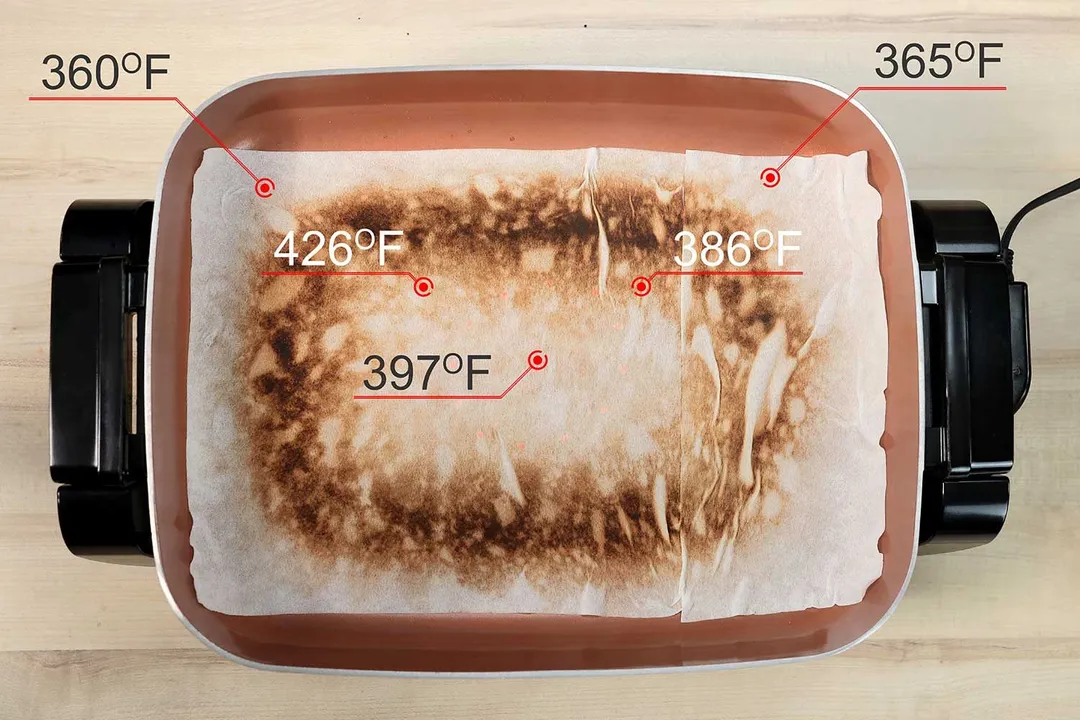
The core heating dynamics of the element can only be known by hands-on testing. For this reason, make sure to read our reviews. We focus on minimum and maximum temperature oscillations and temperature stabilization.
The embedded heating elements usually follow the pan outline. The larger the area they cover, the better the heat distribution is with fewer cold spots.
Top performing skillets only have an average 5% temperature variance across their surface and our heat distribution maps make this easy for you to know.
The heating element acts as a resistor for resistance heating similar to that in regular ovens, toaster ovens, and even electric kettles. The resistance to electricity flow enables the electrical energy to be converted into heat energy. This heat naturally rises, heating the surface of the skillet. The temperature is controlled via a thermostat.
The element also has an on-off heating cycle of slightly increasing and decreasing temperatures, so quite different from a normal cook plate. We found temperatures to stabilize over time, but large oscillations result in low cooking performance. Hence our focus on temperature stabilization in our reviews.
5. Make Sure the Lid is Tempered Glass

All skillets have a glass lid which makes it easier to check on food, retain moisture, and protect from splashing. With deep pans, a lid can turn your skillet into a hotpot.
It's best to go for a lid with a steam vent, unless the pan has a pouring spot. Without a vent, pressure can cause the lid to wiggle and shift a bit to let steam escape. This can be unsafe with hot liquid also splashing onto your counter.
Most lids are made from tempered glass, but it’s good to check anyway. Compared to normal glass, or annealed glass, tempered glass is about four times stronger. It is also safer if it breaks because the shards are more blunt.
Lids will also have a stay-cool knob made from either metal or thermosetting plastic. This means they won’t deform at high temperatures, so they are dishwasher-safe.
6. Go For a Detachable Base

Similar to the lid handle, the base for an electric skillet is usually thermosetting plastic or metal. Check to make sure the base has good anti-slip pads.
Electric skillets are commonly designed with their base fixed to the pan. When this is the case, the base usually extends into the side handles for the pan as well.
However, a detachable base is more dishwasher-friendly and generally easier to store away. This is particularly true for large-sized skillets, and besides, detachable bases usually don’t cost more than their fixed counterparts.
7. Cool-to-Touch Handles for Safety

Most electric skillets are designed with two side handles. It is important to make sure the handles are heat resistant if you need to bring your tasty dish from the kitchen to the table. It’s also better to get textured handles for a more secure grip.
8. Make Sure the Thermostat is Removable
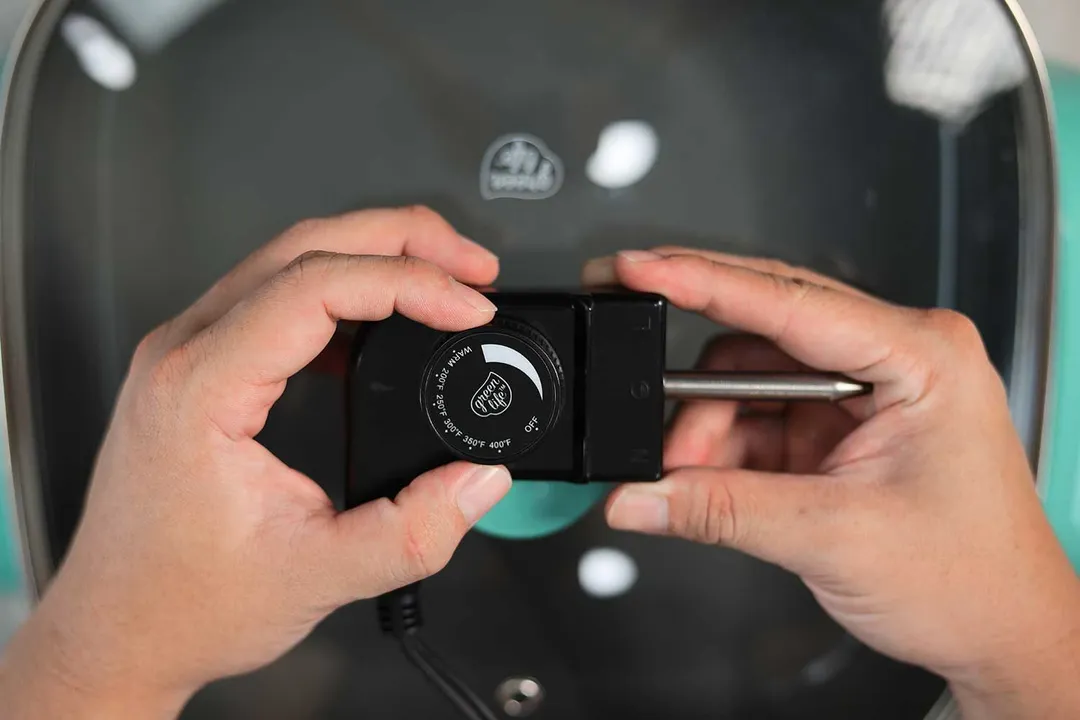
The thermostat will usually have a temperature control dial made of thermosetting plastic and metal rod that connects into the heating element socket.
Most thermostats are detachable these days, but it’s good to check nonetheless. Detachable thermostats make cleaning all the more easier, but they should not be immersed into water.
The general temperature range is 200 to 400°F in 50°F increments, but a keep warm function of 150°F adds more versatility. We recommend picking an electric skillet with a wide temperature range for more versatile cooking.
5 Reasons Why Should You Buy an Electric Skillet
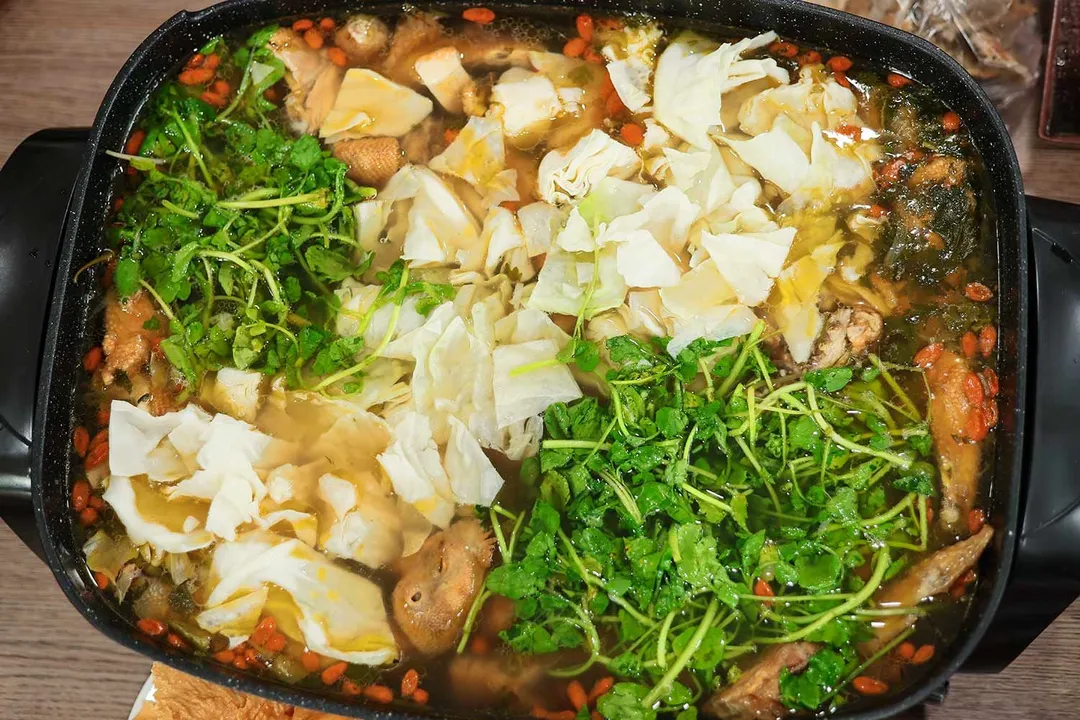
Here are five reasons why you should get an electric skillet if you’ve never tried one before.
1. They are Convenient and Versatile
Small electric skillets are great for apartments, dorms, studios, and kitchenettes while large ones can cook multiple dishes at the same time. Their relatively large cooking surface is suitable for sautéing, frying, steaming, and even making hotpots.
An electric skillet can also provide an additional cooking surface when needed and their portability can reduce cramping in the kitchen.
2. Faster and More Efficient Cooking
With the heating element embedded inside the cooking pan, electric skillets heat up faster, are more efficient, and can cook faster than a normal cooktop. They also give you more precise temperature control.
3. You Can Keep Food Warm
An electric skillet can be a potential party saver, and not just for the additional cooking space. Make sure your skillet has a Keep Warm function because you never know when you may need it. You can even prep dishes in advance and arrange them buffet style in a larger skillet.
4. Makes For a Cooler Kitchen
Since the heating element is inside the pan itself, electric skillets release less heat into their surroundings. Not to mention, you can always cook outside when cooking indoors just gets too steamy. Just make sure to place them 4 inches away from any wall.
5. Take Your Skillet On the Road
Whether you live in a mobile home or just vacation in one, an electric skillet is a neat appliance. They come in a versatile size range, heat up fast, cook efficiently, and are easy to clean and pack away. If your camping site has an electric outlet, your skillet is in luck!
About your tip
Alan Nguyen is a writer and product reviewer at HealthyKitchen101. His major in English language teaching taught him to present concise information. In addition to his cooking hobby, he values the practical aspects of household appliances.
Nguyen Ntk is a graphic designer, photographer, and videographer whose philosophy centers around respecting and celebrating the beauty of reality. Through his lenses, Nguyen strives to capture the true essence of objects and events, showcasing and highlighting authentic features without distortion or exaggeration.

